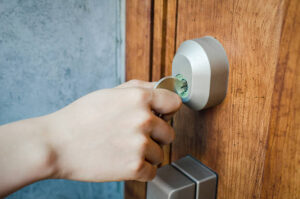Fortifying Your Fortress: How High-Security Locks Prevent Lock Bumping
Ever heard of lock bumping? It’s a sneaky trick that can make your standard locks as useless as a chocolate teapot. That’s why high security door locks are worth their weight in gold.
So, what’s the deal with lock bumping? Picture this: you’ve got an ordinary pin tumbler lock on your front door. A would-be intruder takes a specially crafted “bump key,” inserts it into the lock, and gives it a little tap-tap-tap-a-roo with something like a screwdriver handle or even just another key. Voilà! The pins inside the lock jump up momentarily, aligning perfectly to let anyone twist open your door without breaking so much as a sweat.
Sounds terrifyingly simple, right? That’s because it is. Lock bumping exploits basic physics—kinetic energy transfer—to manipulate those tiny pins inside your average Joe Schmoe locks.
Now imagine you’re trying to keep out not just burglars but Houdini himself. This is where high-security locks come into play. These bad boys aren’t playing around; they’ve got all sorts of tricks up their sleeves to thwart any attempts at unauthorized entry.
First off, many high-security locks feature complex pin designs and unique configurations that render traditional bump keys ineffective. Think of them like puzzles designed by evil geniuses who want nothing more than to see criminals fail spectacularly.

Another nifty innovation is sidebars or secondary locking mechanisms that require additional steps beyond simply lining up pins vertically within the cylinder housing—sorta like adding extra layers in an onion but way less smelly and tear-inducing!
High-security locks also employ hardened steel inserts and anti-drill plates. Imagine trying to drill through a tank—yeah, good luck with that! These components make it nearly impossible for someone to tamper with the lock using brute force or drilling techniques.
Let’s not forget about key control. With standard locks, duplicating keys is as easy as pie; you can waltz into any hardware store and get a copy made in minutes. High-security locks? Not so much. Their keys are often patented and require specialized equipment for duplication, meaning only authorized dealers can make copies. This drastically reduces the risk of unauthorized duplicates floating around like confetti at a parade.
Ever heard of magnetic pins? Some high-security systems incorporate magnets within their mechanisms, adding yet another layer of complexity to deter bumping attempts. It’s like putting up an invisible force field around your home!
And then there’s electronic high-security locks—these guys take things to a whole new level by integrating digital technology into traditional locking systems. Fingerprint scanners, keypads, smart cards—you name it! The sheer variety makes them adaptable to different security needs while offering enhanced protection against old-school bumping tricks.
But hey, let’s keep our feet on the ground here: no lock is entirely foolproof if someone has enough time and resources (and perhaps James Bond-level skills). However, investing in high-security door locks significantly ups your game against most would-be intruders who’d rather move on than face such formidable barriers.
So next time you’re pondering how best to safeguard your castle—or even just your cozy little abode—remember that those extra layers of security aren’t just bells and whistles; they’re solid defenses standing between you and potential threats lurking out there in the shadows.
How High-Security Locks Keep You Safe
Ever heard of lock bumping? It’s a sneaky technique burglars use to break into homes. But there’s good news! High security door locks are designed specifically to combat this trickery. Let’s dive into how these advanced locks keep your home safe and sound.
Lock bumping isn’t rocket science; it involves inserting a specially cut key (a “bump key”) into the lock and giving it a tap, causing the pins inside to jump just enough for the lock to turn. Sounds simple, right? That’s why it’s so scary! Anyone with basic knowledge can learn this in minutes. So, what makes high-security locks such formidable opponents against this method?
First off, high-security locks come with unique pin configurations that make them tough nuts to crack. Standard locks have simple pin setups that are easy targets for bump keys. In contrast, high-security models boast intricate designs like spool pins or mushroom pins which react differently when bumped—making it nearly impossible for intruders.
Take Medeco’s patented design as an example; their locking mechanisms feature angled cuts on both the key and pins. This requires precise alignment before turning—a feat not achievable by merely tapping with a bump key.
Moreover, some brands incorporate sidebar mechanisms along with traditional pin tumblers. These sidebars need specific lateral movements alongside vertical ones from the pins before they release their grip on the cylinder core—double trouble for any would-be burglar!
But wait, there’s more! Some manufacturers go even further by using magnetic elements within their cylinders or adding electronic components requiring digital codes in addition to physical keys—talk about layers of protection!
Remember those horror stories where thieves bypassed alarms but couldn’t get past old-school deadbolts? That’s because mechanical solutions still hold significant value today if engineered correctly.
And let me tell you about pick-resistant features too: Imagine trying all day long without success—it feels like pushing water uphill! High-security models often integrate complex warding patterns inside their cores making picking attempts futile at best while leaving crooks frustrated beyond belief.
Let’s not forget about key control. High-security locks often come with restricted keys that can’t be duplicated at your local hardware store. You need authorization to get copies made, adding another layer of security. This isn’t just a fancy feature; it’s peace of mind knowing only you and trusted individuals have access.
And then there’s the material itself—these locks are built like tanks! Constructed from hardened steel or other robust materials, they can withstand brute force attacks that would make lesser locks crumble. It’s like comparing a paperclip to a crowbar!
But here’s where things get really interesting: some high-security locks even offer drill-resistant plates and anti-snap features. Imagine trying to break into Fort Knox with a toothpick—that’s what these enhancements do for your front door.
You might think all this tech makes them tricky to use, but you’d be wrong! They’re user-friendly while being tough as nails against unwanted entry attempts.






